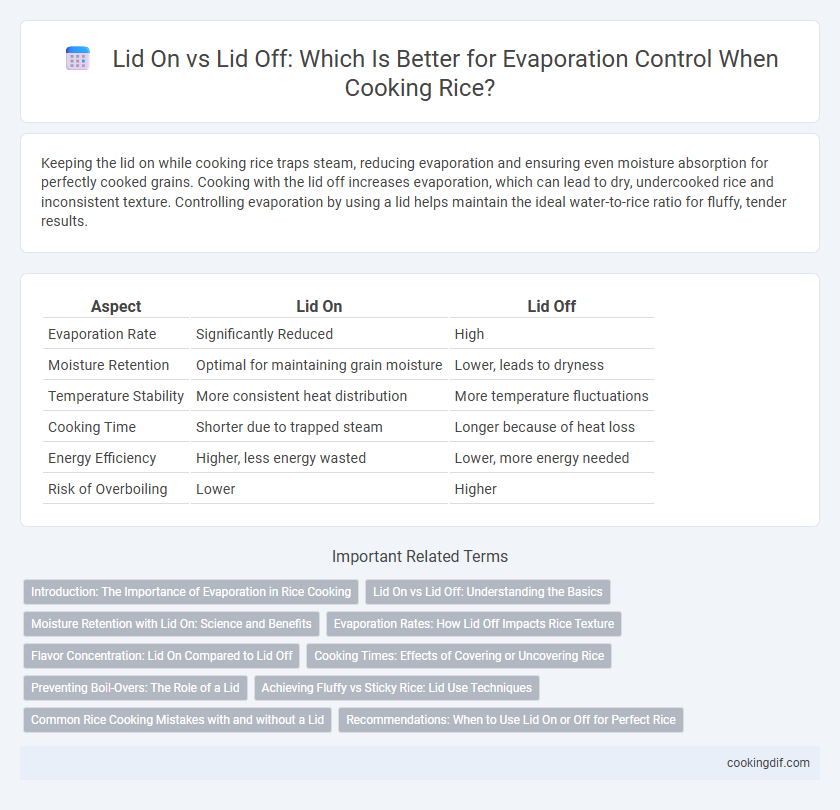Keeping the lid on while cooking rice traps steam, reducing evaporation and ensuring even moisture absorption for perfectly cooked grains. Cooking with the lid off increases evaporation, which can lead to dry, undercooked rice and inconsistent texture. Controlling evaporation by using a lid helps maintain the ideal water-to-rice ratio for fluffy, tender results.
Table of Comparison
| Aspect | Lid On | Lid Off |
|---|---|---|
| Evaporation Rate | Significantly Reduced | High |
| Moisture Retention | Optimal for maintaining grain moisture | Lower, leads to dryness |
| Temperature Stability | More consistent heat distribution | More temperature fluctuations |
| Cooking Time | Shorter due to trapped steam | Longer because of heat loss |
| Energy Efficiency | Higher, less energy wasted | Lower, more energy needed |
| Risk of Overboiling | Lower | Higher |
Introduction: The Importance of Evaporation in Rice Cooking
Controlling evaporation during rice cooking significantly impacts texture and moisture retention, with the lid on minimizing water loss and promoting even heat distribution. Cooking rice with the lid off increases evaporation, leading to drier grains and longer cooking times. Optimal evaporation management, achieved by using a lid, ensures consistent starch gelatinization and prevents nutrient depletion.
Lid On vs Lid Off: Understanding the Basics
Lid on during rice cooking traps steam to maintain consistent moisture and temperature, reducing evaporation and ensuring even grain texture. Lid off allows excess moisture to escape, which can prevent sogginess but may require more water and longer cooking time. Understanding these basics helps optimize rice texture and cooking efficiency based on desired results.
Moisture Retention with Lid On: Science and Benefits
Keeping the lid on during rice cooking traps steam, significantly reducing evaporation and preserving moisture within the grains. This method enhances rice texture by ensuring uniform hydration and prevents nutrient loss caused by excessive water escape. Scientific studies show that moisture retention under a covered pot improves the overall quality and flavor profile of cooked rice.
Evaporation Rates: How Lid Off Impacts Rice Texture
Leaving the lid off during rice cooking increases evaporation rates by allowing steam to escape freely, which reduces moisture retention and results in firmer, less sticky rice. Higher evaporation causes water to evaporate faster, concentrating starches and altering the rice's texture to a drier, chewier consistency. Controlling evaporation by adjusting lid position directly influences the final texture and moisture content, making lid placement a critical factor in rice preparation.
Flavor Concentration: Lid On Compared to Lid Off
Using a lid during rice cooking traps steam and moisture, intensifying flavor concentration by preserving aromatic compounds within the pot. Cooking rice with the lid off allows more evaporation, leading to a lighter taste but reduced depth of flavor. The lid-on method enhances the rice's natural fragrances and texture by maintaining a controlled, moist environment.
Cooking Times: Effects of Covering or Uncovering Rice
Cooking rice with the lid on retains steam, significantly reducing cooking time by maintaining a consistent temperature and moisture level. Cooking rice with the lid off increases evaporation, which can extend cooking times and result in drier, less evenly cooked grains. Optimal rice texture and efficiency usually occur with the lid on, as it ensures proper moisture absorption and uniform heat distribution.
Preventing Boil-Overs: The Role of a Lid
Using a lid on a pot while cooking rice significantly reduces evaporation by trapping steam, which stabilizes the temperature and water levels, thereby preventing boil-overs. The lid creates a controlled environment where pressure builds slightly, minimizing the rapid bubble formation that often causes spillage. Keeping the lid in place ensures even heat distribution and consistent moisture retention essential for perfectly cooked rice without messy boil-over incidents.
Achieving Fluffy vs Sticky Rice: Lid Use Techniques
Using a lid on during cooking traps steam and moisture, resulting in fluffy rice with separate grains as the trapped steam evenly cooks the rice. Cooking rice with the lid off allows excess moisture to evaporate, producing stickier rice with a clumpier texture preferred in dishes like sushi or risotto. Mastering lid techniques directly influences rice's moisture content, texture, and overall mouthfeel, crucial for achieving desired culinary outcomes.
Common Rice Cooking Mistakes with and without a Lid
Cooking rice with the lid off causes excessive evaporation, leading to dry, undercooked grains and uneven texture due to inconsistent steam retention. Using a lid traps moisture and heat, ensuring uniform cooking and preventing water loss that results in burnt or crispy rice at the bottom of the pot. A common mistake is removing the lid frequently, which disrupts steam circulation and prolongs cooking time, compromising the rice's fluffy consistency.
Recommendations: When to Use Lid On or Off for Perfect Rice
Using the lid on during rice cooking traps steam and heat, ensuring even moisture absorption and fluffy texture, ideal for white and basmati rice varieties. Leaving the lid off allows excess moisture to evaporate, beneficial for sticky or risotto-style rice where a dryer consistency is preferred. For perfectly cooked rice, keep the lid on during simmering and remove it briefly toward the end if a firmer, less sticky grain is desired.
Lid on vs Lid off for evaporation control Infographic

 cookingdif.com
cookingdif.com